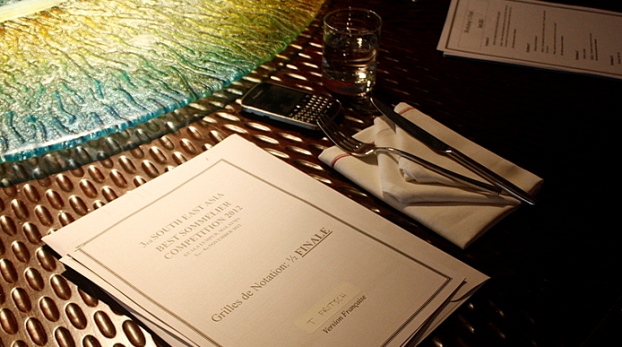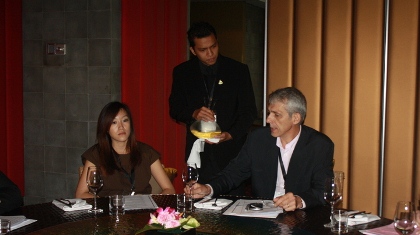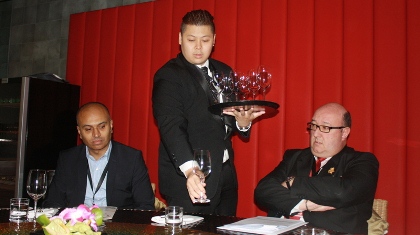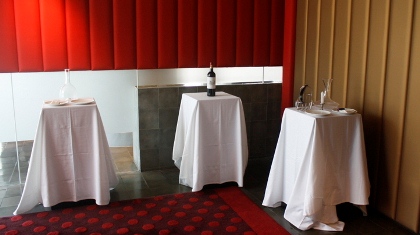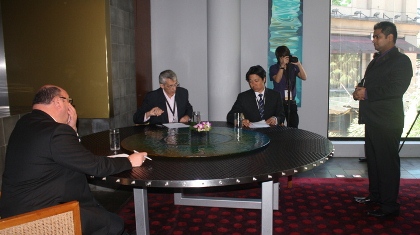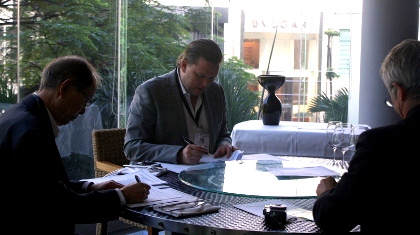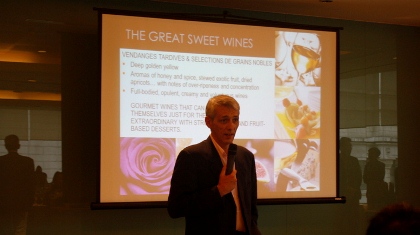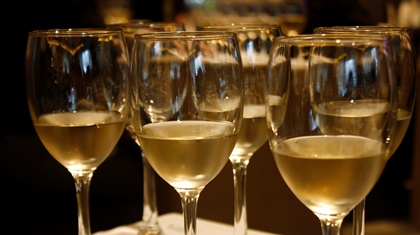Day 2
Semi Finals 1
List of contestants
Indonesia
Hezron Febriando (Amuz Gourmet)
Togu Sahat (Cork & Screw)
Malaysia
Edmund Liew (In Vino Veritas)
Han Yew Kong (Osteria Mozza)
Singapore
Alan Au Kok Hoong (Osteria Mozza)
Indra Kumar (Buyan – Russian Fine Dining)
Taiwan (friendly participation)
Chang Hsun Yeh (The Ambassador Hotel)
Max Lin Che Wei (Le Mout Restaurant)
Thailand
Chalong Songkroh (Anantara Phulet Villas)
Monthira Longthong (Hilton Millennium Bangkok)
Vietnam
Pham Quang Trung (Oriental Saigon)
Tran Duong Tho (Crowne Plaza West Hanoi Hotel)
The first round of assessment on practical knowledge for the sommeliers started early at 9am. Two stages of the first session took place in 3 different rooms.
First, each contestant was required to serve a bottle of wine to 6 guests at a round table, with 2 guests yet to arrive. Choosing the right glass for the wine recommended, wine decanting technique and serving sequence were assessed. It was interesting to see how different each sommelier interacted with their guests and where they choose to place the table for decanting.
After completing the first stage, the contestant would be asked to enter the adjacent room for the second assessment. In this room, there were three tables, one with a wine table stand, one with a bottle of wine and the last one with wine table stand and decanting tools. The contestant was asked:
“Choose among the tables displayed there (refer to photo below) to serve the bottle of wine on the middle table, with no time limit.”
The three tables
What crossed the contestant’s mind after hearing the question must have been confusion. The assessment of decanting technique was already assessed in the previous room, would this be a second trial? Or, this must have been a trick question, choosing a table? Wouldn’t that be too easy? For the readers’ benefit, the bottle of wine on the middle table was a vintage. The answer was simple: choose the table with the proper decanting tools. Most of the contestants were stunt while they were asked to stop right after they have chosen the table, thinking that there would be more to do. When the audience found out the answer from the first contestant, the rest of the observation in that room became a biting nail experience as to whether the contestants understood the question.
Indra Kumar (far left) in the second room; Judges (from left) Jean Pascal Paubert, Thierry Fritsch and Hiroshi Ishida.
The third room was for the assessment of costs and menu preparation based on the number of guests attending and wines provided. The contestant was asked to estimate the number of bottles required for a function of 50 people and to suggest a menu for the type of wine served.
Alsace Wine Seminar
The master class was conducted by Thierry Fritsch, the Oenologist and Training Manager from Conseil Interprofessionel des Vins d’Alsace. The Alsace wine characteristic is very much affected by its terroir, which is a productive combination of grapes, climate soil and the winemaker. All the vinyards in Alscase face the same direction and hence receive the same amount of sun and rain each year. The warm days and cool nights give a slow maturation on the grapes grown in this region and hence develop complex aromas, fresh and fruity wines with good structure and mature acidity.
Thierry went through the formation of soils and sub-soils in Alsace, showing presentation on the 13 different type of geological formations that give the condition for wide range of varietals. However, there are 7 main varietals which Alsace winemaking tradition is based on, each varietal has its favourite type of soil and the aim is to find the terroir which best suits each grape. The seven main varietals are Sylvaner, Pinot Blanc, Riesling, Muscat d’Alsace, Pinot Gris, Pinot Noir and Gewurstramine [Gi-werks-za-mi-ner].
The pairing and the serving temperature of each varietal was suggested. Discover the full experience of Alsace wines at AlsaceWine.com.
